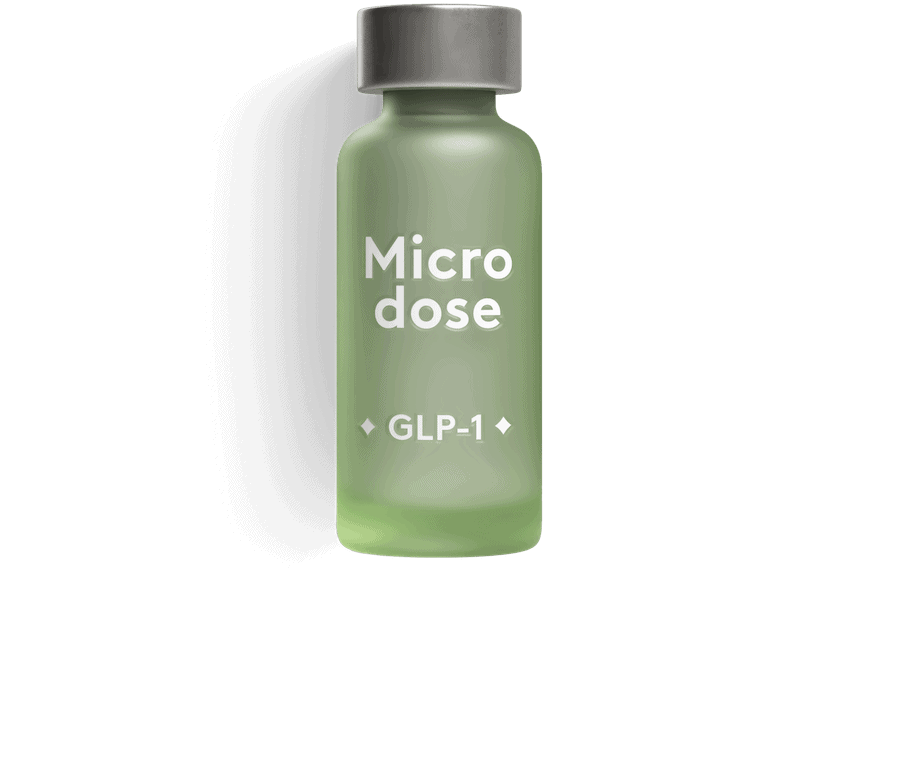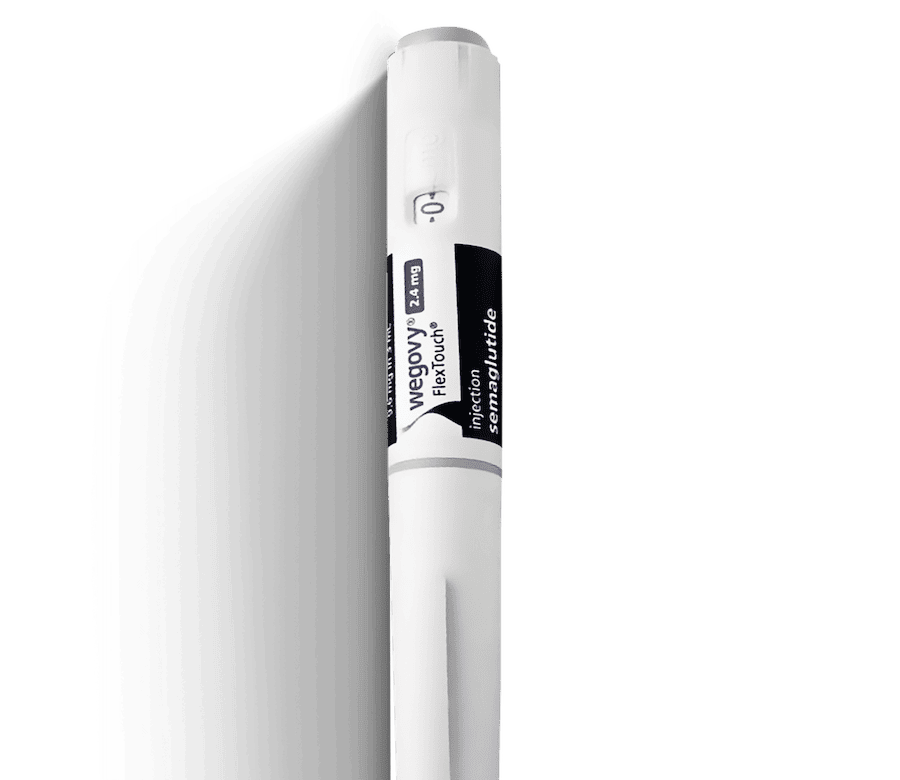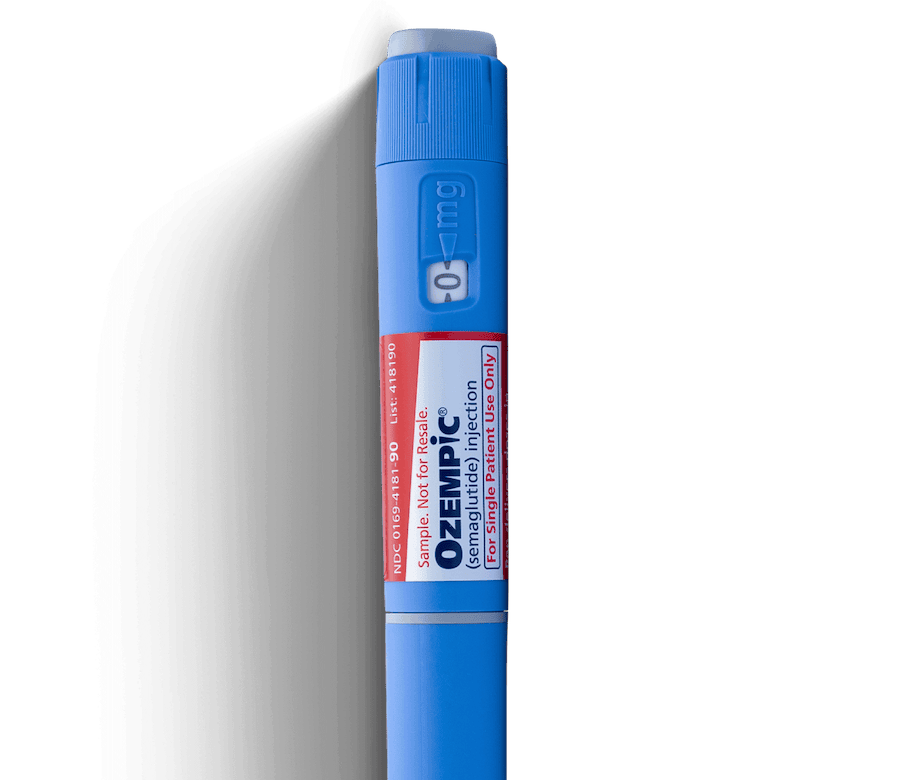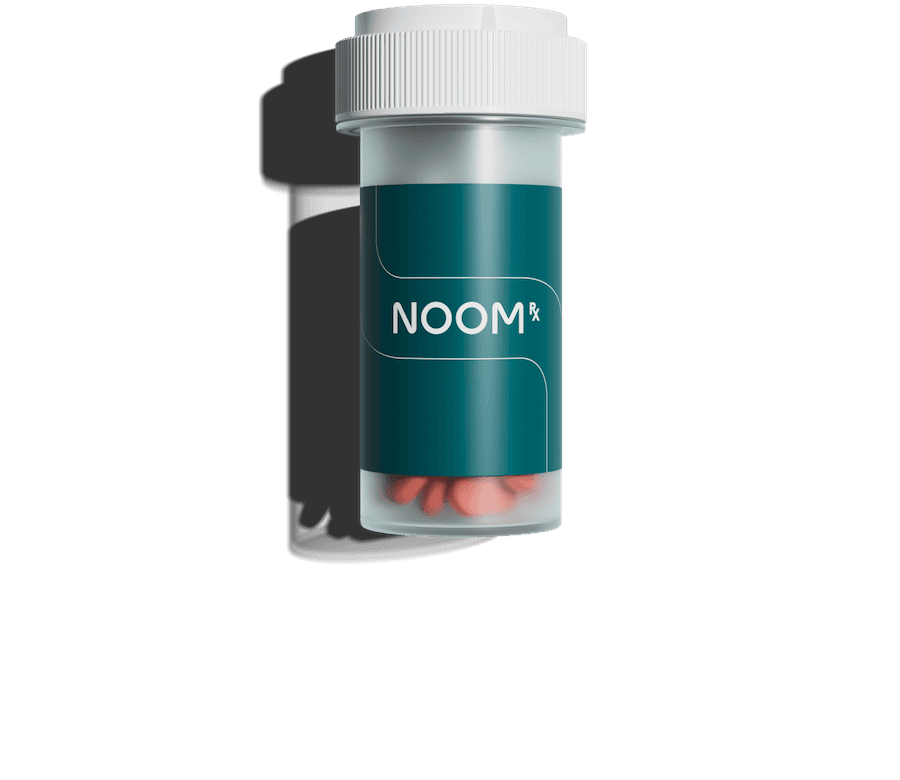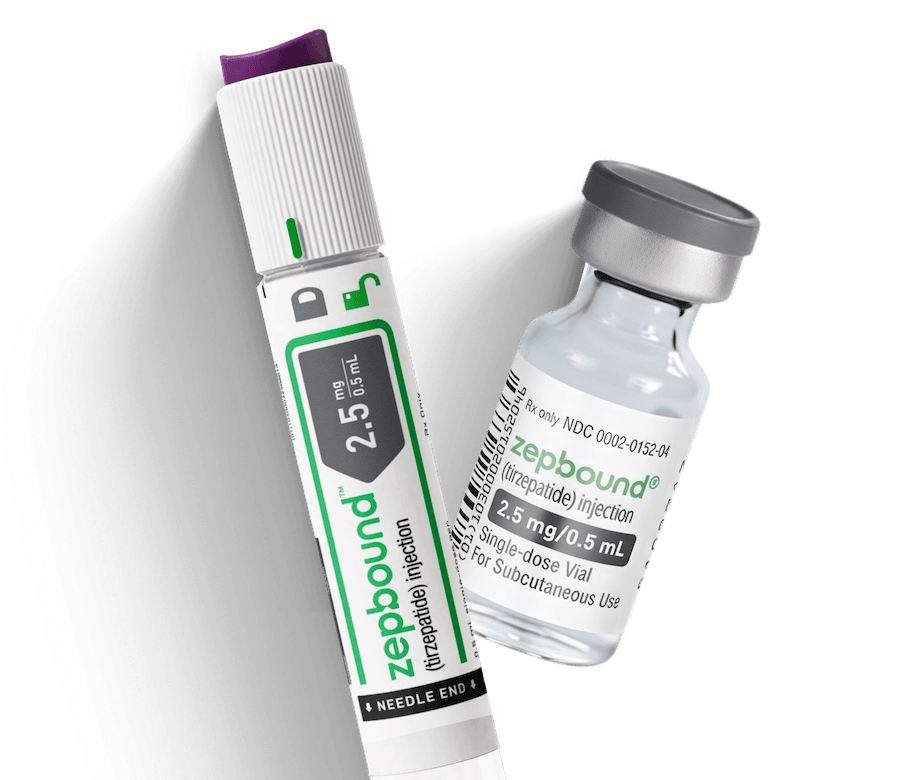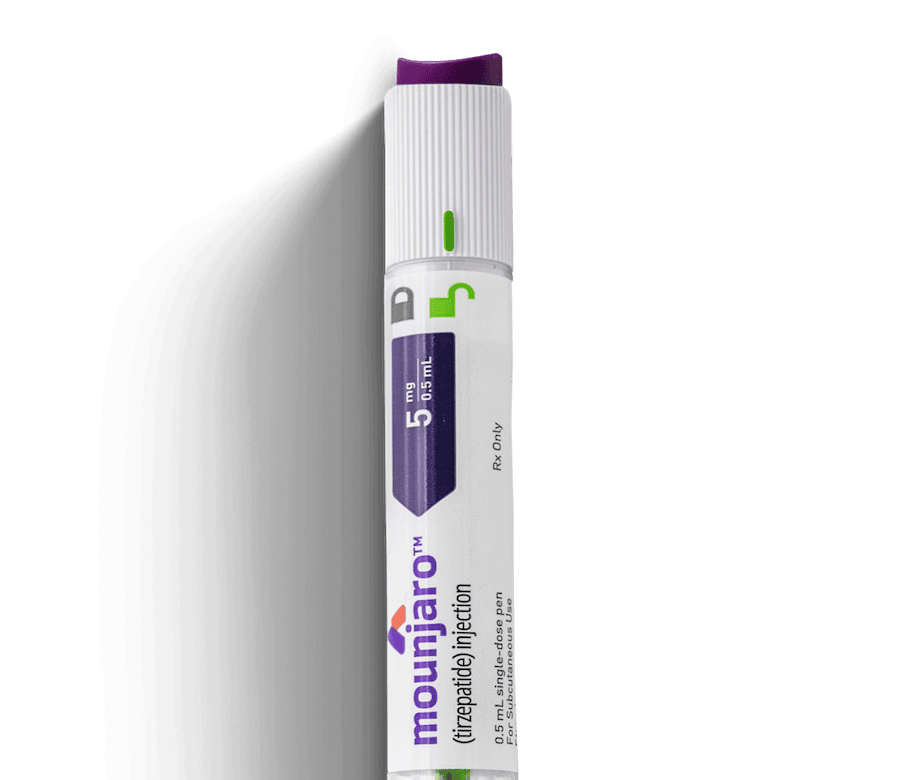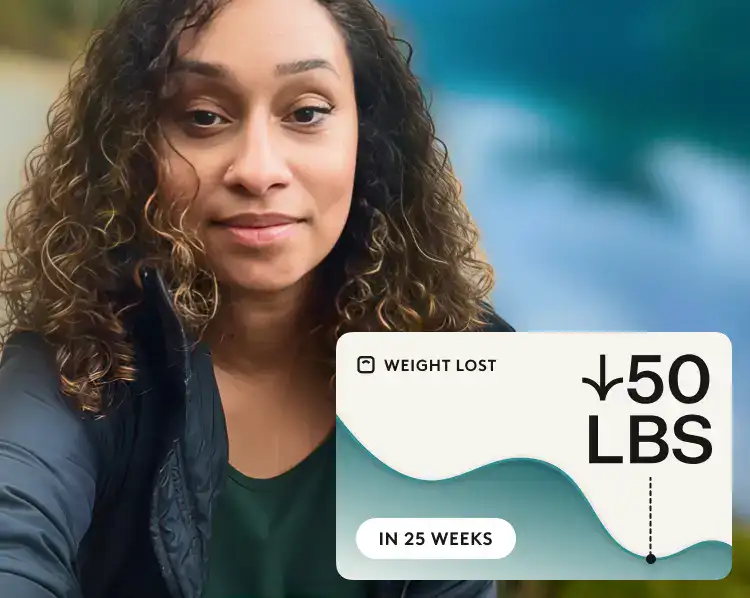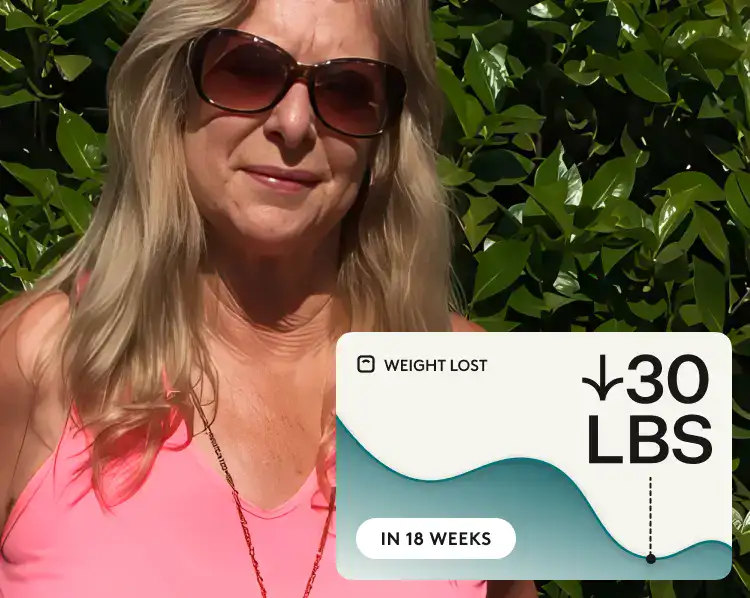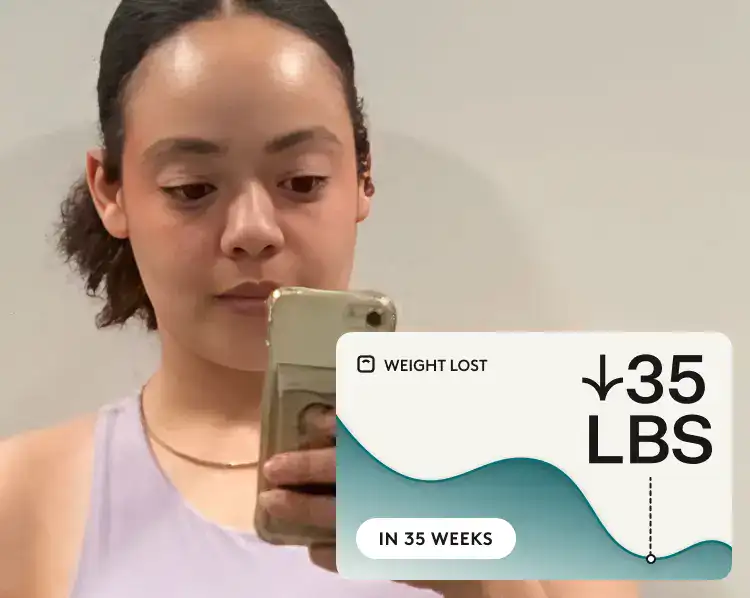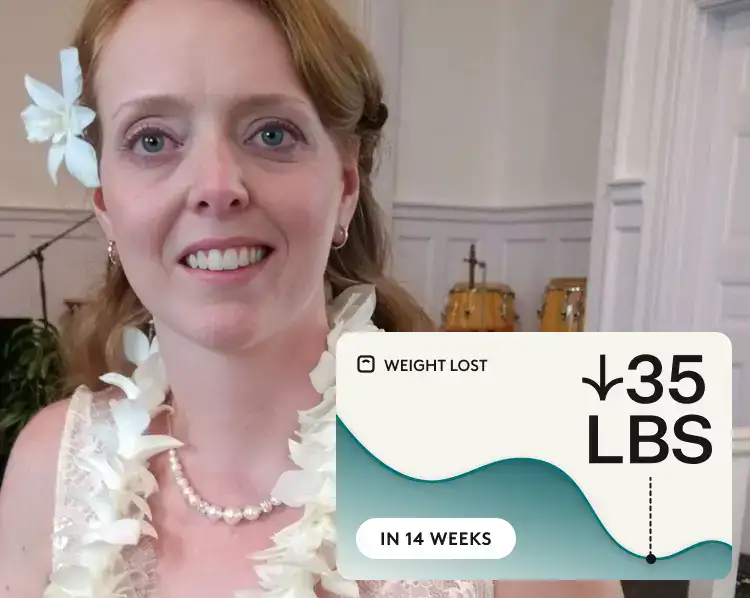What you’ll learn:
- Zepbound® and Qsymia® are both FDA-approved medications for weight loss, but they work differently.
- Zepbound’s active ingredient is tirzepatide, a drug that mimics GLP-1 and GIP. Qsymia® contains phentermine and topiramate, which work together to lower appetite and curb cravings.
- Zepbound® tends to lead to greater average weight loss than Qsymia®, but the best choice depends on several factors.
Losing weight can feel like navigating a maze of options. You have your choice between pills, injections, diets, lifestyle programs, and every combination in between. If you’re thinking about medication, two options you can consider are Zepbound® and Qsymia®. Both are FDA-approved for weight loss, but they work in very different ways.
- Zepbound®, approved in 2023, uses tirzepatide, a medication that mimics gut hormones to help control appetite, slow digestion, and improve blood sugar management. You take it by an injection you give yourself once a week.
- Qsymia® was approved in 2012 and combines phentermine and topiramate, two drugs that act on the brain to help reduce hunger and make you feel full sooner. It’s taken as a pill once a day.
They both aim to support weight loss, just through completely different systems in the body.
Since they are so different, how you take them, side effects, cost, and insurance coverage can vary widely between the two.
If you’re trying to decide between Zepbound® and Qsymia®, it helps to look closely at how they work, what kind of results to expect, and what might make one a better fit for your goals. Let’s take a closer look at how these two medications compare.
Zepbound® vs. Qsymia®: How do they work?
Understanding how Zepbound® and Qsymia® help you lose weight can help you decide which might fit better with your health goals.
Zepbound® (tirzepatide)
When injected once a week, the tirzepatide in Zepbound mimics two key gut hormones that play major roles in managing appetite and regulating blood sugar, GLP-1 and GIP. Let’s take a look at them:
- GLP-1 (glucagon-like peptide-1): This hormone is naturally released by your intestines after you eat to regulate appetite, slow digestion, and lower blood sugar. Zepbound amplifies and extends these effects.
- GIP (glucose-dependent insulinotropic polypeptide): Secreted in the small intestine, GIP works mainly in the pancreas to help regulate insulin release and blood sugar levels. Its receptors are also found in fat, bone, heart, brain, and adrenal tissue, where it helps influence energy balance and metabolism, making it a key partner to GLP-1 in supporting weight management.
When tirzeatide activates these hormones together, appetite decreases, you feel full sooner, and stay satisfied longer. This dual activity also improves insulin sensitivity and may enhance fat metabolism.
Learn more about how Zepbound® works.
Qsymia® (phentermine/topiramate)
Qsymia® is a combination medication in pill form that combines two active ingredients, phentermine and topiramate. Together, these two drugs influence appetite control and food behavior. Both of these medications are used on their own for different purposes.
- Phentermine: This medication is a stimulant that is believed to increase levels of norepinephrine in the part of the brain responsible for hunger signals. This helps suppress appetite, making it easier to reduce food intake throughout the day. Phentermine is available on its own and FDA-approved for short-term weight loss.
- Topiramate: Used on its own to manage seizures and migraines, topiramate is thought to affect several brain pathways that help curb appetite and influence how rewarding certain foods feel. Animal research also suggests that topiramate can improve how the body stores and uses fat. Some people use it off-label for weight loss.
The result of combining these two medications into Qsymia is a synergistic effect that helps you eat less, feel satisfied with smaller meals, and experience fewer food cravings.
Learn more about how Qsymia® works.
Zepbound® vs. Qsymia®: What are the differences?
While both Zepbound® and Qsymia® are prescribed to support weight loss, they differ in a lot of ways. Here’s how they compare:
They’re taken differently
Zepbound® is a once-weekly injection given under the skin, and Qsymia® is a daily pill taken by mouth.
They have different active ingredients that target different systems
- Zepbound® uses tirzepatide, a dual-action compound that, as we described, mimics two natural gut hormones (GLP-1 and GIP). These hormones help regulate appetite, digestion, and blood sugar, making it easier to eat less and stay full longer.
- Qsymia® combines phentermine, a stimulant that suppresses hunger, with topiramate, a medication that enhances feelings of fullness and can reduce cravings. Instead of working through hormone signaling, it acts directly on brain pathways that control appetite and reward responses to food.
Only Qsymia® has a generic version
Zepbound® is still under patent protection until 2036, so a generic version isn’t available until then. Qsymia®, on the other hand, does have a generic form of its phentermine/topiramate combination, which can make it a more budget-friendly option depending on your pharmacy and insurance coverage. We’ll go through the price comparison below.
Their side effect profiles are different
- Zepbound® most commonly causes mild gastrointestinal symptoms like nausea, vomiting, or constipation as your body adapts to changes in digestion.
- Qsymia® may lead to side effects such as dry mouth, tingling in the hands or feet, or trouble sleeping, mostly related to its stimulant and neurological effects.
Zepbound® vs. Qsymia®: What are the similarities?
Even though these two medications work in entirely different ways, they do share a few important things in common. Understanding these similarities can help you know what to expect when starting either medication.
Both require a prescription
Both Zepbound® and Qsymia® are prescribed for adults with a BMI of 30 or higher, or 27 and above with a weight-related condition like high blood pressure or high cholesterol. They’re designed to be used alongside healthy eating, physical activity, and long-term habit changes to support lasting results.
Both start low and increase gradually
Whether you’re taking a weekly Zepbound® injection or a daily Qsymia® pill, you’ll begin at a lower dose that’s slowly increased over time. This gradual adjustment helps your body adapt, minimizing early side effects and improving comfort as the medication takes effect. It’s a step-by-step process that allows your provider to find the dose that feels right for you.
Insurance coverage is often limited
Insurance coverage for any weight loss medication is very unlikely. Before starting either medication, it’s best to check with your provider to understand what your plan will and won’t cover.
Zepbound® vs. Qsymia®: Dosage and administration
Even though Zepbound® and Qsymia® are started at lower doses and increase slowly to help your body adjust comfortably, they follow very different dosing schedules.
Here’s a side-by-side comparison of how each one is typically prescribed and adjusted over time:
| Dosing details | Zepbound® (tirzepatide) | Qsymia® (phentermine/topiramate ER) |
|---|---|---|
| How it’s taken | Weekly injection in the upper arm, thigh, or stomach | Daily capsule taken by mouth |
| Available formats | Prefilled single-dose pen or vial and syringe | Extended-release capsule |
| Available doses | 2.5 mg, 5 mg, 7.5 mg, 10 mg, 12.5 mg, and 15 mg | 3.75 mg/23 mg, 7.5 mg/46 mg, 11.25 mg/69 mg, and 15 mg/92 mg |
| Starting dose | 2.5 mg once weekly for 4 weeks | 3.75 mg / 23 mg once daily for 14 days |
| Dose escalation schedule | Increased every 4 weeks as tolerated and needed. | After 14 days, dose is increased to 7.5 mg / 46 mg once daily. If less than 3% weight loss after 12 weeks, dose may increase to 11.25 mg / 69 mg for 14 days, then to 15 mg / 92 mg daily if tolerated. |
| Maintenance dose | Determined by your provider based on response and side effect tolerance | 7.5 mg / 46 mg once daily is the recommended dose |
| Maximum dose | 15 mg once weekly | 15 mg / 92 mg once daily |
| Titration goal | Gradually increase to the lowest effective dose that supports sustainable weight loss | Step up only as needed if progress plateaus and side effects are manageable |
Each medication uses a steady, personalized titration plan to help minimize discomfort and maximize results. Your provider will adjust the pace based on how well you tolerate each step and how your weight loss progresses.
Learn more about Zepbound® and Qsymia® dosing.
Zepbound® vs. Qsymia®: Which is better for weight loss?
Both medications can help reduce body weight when paired with healthy habits, but their effectiveness differs. When it comes to weight loss, Zepbound® tends to lead to greater results on average than Qsymia®.
How much weight can you lose on Zepbound® vs. Qsymia®?
Long-term studies for both medications show that consistent use can lead to real progress when combined with healthy habits.
- Zepbound®: In a 72-week trial, people lost an average of 21% of their starting weight on the highest dose of Zepbound (15 mg).
- Qsymia®: In a 56-week trial, people lost an average of 10% of their starting weight on the highest dose (15 mg/92 mg).
In both studies, people were instructed to follow a balanced, reduced-calorie diet and were offered regular lifestyle counseling sessions.
How long does it take to see results?
Most people begin seeing progress within the first few months of treatment, with results continuing to build over time with both medications. The table below shows the average percentage of body weight lost at key points in weight loss studies for people taking the highest approved doses of each medication.
Zepbound® tends to lead to faster and greater total weight loss over time, while Qsymia® typically plateaus earlier.
Learn more about how much weight you can lose with Zepbound® and Qsymia®.
Who can take Zepbound® or Qsymia® for weight loss?
You may qualify for either Zepbound® or Qsymia® if you:
- Have a BMI of 30 or higher, or
- Have a BMI of 27 or higher and at least one weight-related condition such as high blood pressure or high cholesterol.
Who can’t take Zepbound® or Qsymia® for weight loss?
Not everyone is a good candidate for these treatments, and safety should always come first. Here’s what the prescribing information highlights for each:
You shouldn’t take Zepbound® if you:
- Have a personal or family history of medullary thyroid carcinoma (MTC).
- Have multiple endocrine neoplasia syndrome type 2 (MEN 2).
- Have had a serious allergic reaction to tirzepatide or any ingredient in Zepbound®.
- Are pregnant or planning to become pregnant, since weight loss medications are not recommended during pregnancy.
You shouldn’t take Qsymia® if you:
- Are pregnant, due to the risk of birth defects (particularly oral clefts).
- Have glaucoma or hyperthyroidism.
- Are taking or have recently taken monoamine oxidase inhibitors (MAOIs), a type of antidepressant.
- Have had an allergic reaction to phentermine, topiramate, or other ingredients in Qsymia®.
If you take Qsymia® or Zepbound® to lose weight, will you need to keep taking them forever?
You won’t necessarily be on these medications for life. How long you take them really depends on what your goals are, how your body responds, and what kind of habits you build during treatment.
Here’s what’s usually seen in practice:
- Treatment can last months or years. Long-term studies on both medications have typically followed people for more than 2 years, though your provider may adjust that timeline based on progress and side effects.
- Qsymia® needs to be tapered. Because of how it works in the brain, stopping too quickly can lead to withdrawal symptoms or, rarely, seizures, so your doctor will help you step down safely.
- Zepbound® can usually be stopped without tapering. Still, it’s best to make any changes under medical supervision to help your body adjust smoothly.
- Healthy habits matter most. Both medications work best when paired with a plan that includes balanced eating, daily movement, and a reduced-calorie diet to support lasting weight management.
As with any medication, the best way to sustain your progress is through the habits you build, sticking with nutritious foods, regular activity, and lifestyle routines that help you feel your best long after treatment.
Can you switch between Zepbound® and Qsymia®?
You can, but since these medications work very differently, your healthcare provider will guide you through the transition.
People often consider switching for reasons like:
- Convenience. Some prefer a once-weekly injection over a daily pill, or vice versa.
- Side effects. If one medication causes ongoing nausea, headaches, or other issues, your provider might recommend trying the other.
- Cost or coverage. Insurance plans vary, and one option may be more affordable or covered than the other.
- Access. Sometimes one medication can be hard to find due to supply or pharmacy issues.
Whatever option you choose, your provider will guide you through the process of making the change safely and help you stay on track with your goals.
Rx weight loss, the right way, with Noom
Get access to prescription weight loss medication with Noom.Zepbound® vs. Qsymia®: Costs and insurance
Pricing and insurance coverage can make a big difference when deciding between Zepbound® and Qsymia®. Both medications can support long-term weight management, but their costs, coverage options, and savings programs vary quite a bit. In general, neither is often covered by insurance because weight loss medications still are not routinely covered.
Zepbound®
Zepbound® has a list price of about $1,086 per month for the prefilled pen version. If you use the vial and syringe form through the manufacturer’s LillyDirect program, prices start are:
- $349 for the 2.5 mg starting dose
- $499 for higher doses (5 mg, 7.5 mg, 10 mg, 12.5 mg, and 15mg)
Savings programs: The Zepbound® Savings Card can lower your monthly cost to as little as $25, depending on your insurance coverage.
Insurance coverage and Medicare: Commercial insurance plans rarely cover Zepbound® for weight loss, though they may cover it for obstructive sleep apnea (OSA). Medicare covers Zepbound® for people with moderate to severe OSA, though it doesn’t cover it for weight loss alone.
Learn more about Zepbound® costs.
Qsymia®
The price of Qsymia® ranges from $240 to $300 per month for a 30-day supply, according to GoodRx.
- Savings programs: The Qsymia® Savings Card can reduce your cost by $70–$75 per month. If you’re paying out of pocket, the Qsymia® Engage home delivery program offers a flat rate of $98 per month, which can make ongoing use more predictable.
- Insurance coverage and Medicare: Some commercial insurance plans cover Qsymia®, but coverage for weight-loss medications is still limited. Medicare and Medicaid don’t currently cover Qsymia®, so many people use savings programs or pay out of pocket.
- Generic availability: A generic version of Qsymia is available and usually costs $200 to $250 per month, depending on the pharmacy.
Learn more about the cost of Qsymia®.
Zepbound® vs. Qsymia®: Side effects and safety
Both Zepbound® and Qsymia® can be effective for weight management, but they work in very different ways, which means their side effects are very different. With both, most people experience mild to moderate symptoms as their bodies adjust.
Common side effects
Milder symptoms are the most common and often appear during the first few weeks of treatment. These tend to ease as your body adapts.
Zepbound® (tirzepatide)
Because Zepbound® acts on gut and appetite hormone receptors, most of its early side effects involve digestion. The most common ones include:
- Nausea
- Diarrhea or constipation
- Vomiting
- Abdominal pain
- Indigestion
Qsymia® (phentermine + topiramate)
Qsymia® affects the brain and nervous system, so its typical side effects are more likely to involve mood, energy, and sensations. You might notice symptoms like:
- Dry mouth
- Dizziness or headache
- Tingling in the hands or feet
- Trouble sleeping (insomnia)
- Constipation or nausea
- Changes in taste
- Irritability or anxiety
Want a deeper look at side effects and safety tips for these medications? Learn more about Zepbound® and Qsymia® here.
Is muscle loss a side effect of Zepbound® or Qsymia®?
Muscle loss isn’t listed as an official side effect, but it can happen when weight comes off quickly, something that can occur with any weight loss medication. As your body burns fat stores, it may also break down lean muscle, especially if protein intake or resistance exercise is low.
To protect your strength and metabolism, focus on balanced meals with enough protein and include regular strength training in your routine. If you’re feeling unusually tired or notice muscle weakness, talk with your healthcare provider about adjusting your plan to help maintain lean mass while you lose weight.
Serious side effects and warnings
While serious side effects are uncommon, it’s still important to know what to look out for and when to contact your healthcare provider. If you notice any of the symptoms below, reach out to your doctor right away.
Zepbound®
Though most people tolerate Zepbound® well, there are some rare but serious risks to be aware of. Here are some signs of serious adverse reactions that require immediate attention.
- Pancreatitis: Symptoms include severe stomach pain that may move to your back, sometimes with nausea or vomiting. Go to the emergency room right away.
- Gallbladder issues: Watch out for upper abdominal pain, fever, yellowing of your skin or eyes, or pale stools, and get immediate medical help.
- Kidney problems: You might experience swelling in the legs or ankles, reduced urination, fatigue, or trouble breathing, especially after prolonged vomiting or dehydration. Get immediate medical attention.
- Low blood sugar: If you’re also taking diabetes medication, look out for shakiness, sweating, dizziness, or blurred vision. Get in contact with your doctor immediately..
- Vision changes: For any sudden changes in eyesight or blurred vision seek immediate medical attention.
- Severe allergic reactions: Symptoms include swelling of the face, lips, or throat, rash, or difficulty breathing. Call 911 or go to the nearest ER.
- Thyroid tumors (boxed warning): Although only seen in animal studies, any neck swelling, hoarseness, or trouble swallowing should be evaluated immediately.
Read more about the rare, but serious conditions associated with Zepbound®.
Qsymia®
Because Qsymia® affects the brain and nervous system, some of its serious side effects are tied to mood, metabolism, and kidney function. Knowing what symptoms to watch for helps you act quickly if something feels off.
- Mood or behavior changes: Signs include new or worsening anxiety, depression, irritability, or thoughts of self-harm. If you have thoughts of harming yourself, call 911 or 988 immediately.
- Cognitive changes: Watch for slowed thinking, trouble focusing, or forgetfulness. Report any issues to your provider.
- Metabolic acidosis: Symptoms can include rapid or deep breathing, fatigue, nausea, or an irregular heartbeat. Get immediate medical attention.
- Kidney stones: Be alert for sharp pain in your back or side, painful urination, or blood in your urine. Get immediate medical attention.
- Seizures: If you have a seizure after starting, stopping, or changing your dose, get emergency services right away.
- Overheating or reduced sweating: Feeling faint, flushed, or overheated, especially in warm weather. Move to a cooler place, drink water, and contact your doctor if it doesn’t improve.
- Severe allergic reactions: Symptoms include hives, swelling of the face or throat, or blistering skin. Get emergency medical help immediately.
Staying connected with your healthcare provider throughout treatment for any of these medications is the best way to stay safe. They can adjust your dose, help manage symptoms, and ensure that your plan stays effective and comfortable over time.
Zepbound® and Qsymia®: Which medication is safer?
Both Zepbound® and Qsymia® are FDA-approved and generally safe when used under medical supervision, but they work differently and have distinct risks. The “safer” option depends on your health history and how your body responds.
The best way to find a safe, sustainable option is to work closely with a healthcare provider who understands your whole health picture. They can help tailor your treatment to support lasting, healthy progress.
Choosing between Zepbound® and Qsymia®: Which is right for me?
When comparing Zepbound® and Qsymia®, the best fit depends on your preferences, health goals, budget, and weight loss goals. Below is an overview of everything we went through above to help guide your discussion with your healthcare provider:
| Medication | Zepbound® (tirzepatide) | Qsymia® (phentermine/topiramate ER) |
|---|---|---|
| Effectiveness | People lost an average of 21% of their body weight after 72 weeks at the highest dose. | People lost about 10% of their body weight after 56 weeks at the highest dose. |
| Administration | Once-weekly injection. Available as prefilled pens or single-use vials and syringes via LillyDirect. | Once-daily capsule taken by mouth, usually in the morning. |
| Pricing (without insurance) | Prefilled pens: About $1,086 per month Single-dose vials via LillyDirect: $349 (2.5 mg) or $499 (5, 7.5, 10, 12.5, 15 mg) Learn more | Brand name Qsymia®: $240–$300 per month Generic phentermine/topiramate ER: $200–$250 per month Learn more |
| Active ingredient/s | Tirzepatide: A dual GIP and GLP-1 receptor agonist that helps regulate appetite, blood sugar, and digestion. | Phentermine and topiramate: A stimulant and anticonvulsant combination that reduces hunger and promotes satiety. |
| FDA approval and uses | FDA-approved for weight management and obstructive sleep apnea (OSA). | FDA-approved for weight management. |
| Manufacturer | Eli Lilly | Vivus |
| Insurance coverage | Coverage for weight loss use is uncommon. Some plans may cover Zepbound® when prescribed for OSA. | Coverage for weight loss use is uncommon. |
Alternatives to Zepbound® and Qsymia®
If Zepbound® or Qsymia® doesn’t feel like the right fit, you still have options. Several other FDA-approved weight-management medications work in different ways to help with appetite control, metabolism, or fat absorption. Here’s a quick look at what else is available and how these alternatives compare.
| Medication | Brand names and uses | Cost per month (without insurance) | Effectiveness | How it’s taken |
|---|---|---|---|---|
| Semaglutide – GLP-1 receptor agonist | Wegovy®: weight loss and heart disease | $1,350 $499 (NovoCare Pharmacy) Learn more | People lost an average of 15% of body weight in 68 weeks their body weight. | Weekly injection |
| Liraglutide – GLP-1 receptor agonist | Saxenda®: weight loss Generic liraglutide: weight loss, type 2 diabetes, and heart disease | Saxenda®: $1,350 Learn more. Generic liraglutide: $470 – $700 | People lost an average of 5-6% of body weight in one year. | Daily injection |
Other medications
GLP-1 medications aren’t the only path to weight management. If they’re not the right fit for you, your provider may suggest other treatments designed to support safe and consistent results.
| Medication | Brand names | Cost per month (without insurance) | Effectiveness | How it’s taken |
| Metformin (off-label weight loss) | Glucophage®, Fortamet®, Glumetza® | Generic: $4–$15 Brand name: $100–$500+ Learn more. | People lost an average of about 6% of their body weight over six months while taking metformin. | Pill taken up to two times daily |
| Phentermine | Lomaira®, Adipex-P® | $27-$100 Learn more. | About 80% of people with a BMI of 30 or more lost at least 5% of their body weight in 6 months. | Daily pill |
| Diethylpropion | Tenuate®, Tenuate Dospan® | $40-$85 | People lost an average of 10% of their body weight in 6 months. | Pill taken one to three times daily |
| Naltrexone and bupropion | Contrave® | $600-$800 CurAccess™: $99 | People lost an average of 7 to 8% of their body weight in a year. | Pill taken up to twice daily |
| Orlistat | Xenical®, Alli® | $50-$800 | People in a study lost about 10% of body weight after taking Orlistat for 1 year. | Pill taken three times daily with meals. |
Finding your best fit with Zepbound® or Qsymia®
Zepbound® and Qsymia® are both proven to help with weight loss, but they work in very different ways.
- Zepbound® mimics natural gut hormones (GLP-1 and GIP) to reduce appetite, slow digestion, and regulate blood sugar.
- Qsymia® combines phentermine and topiramate to help your brain regulate hunger cues so you crave less and feel full longer.
Zepbound® tends to deliver greater weight loss results, an average of 21% of body weight in long-term trials, while Qsymia® averages around 10%. But Qsymia® costs less and comes in pill form, making it more practical for many people.
Whichever you choose, success depends on pairing your medication with steady habits like balanced eating, regular movement, and ongoing support from your healthcare provider.
If you’re thinking about weight loss medication, see if you qualify for Noom Med. If so, you’ll be connected with licensed clinicians who can find the right medication for you, prescribe it, if needed, and offer personalized support. You’ll also get access to the full collection of Noom tools and trackers to plan your weekly menus, increase your fitness level, and reach your goals.
Note: Metformin is not FDA-approved to treat obesity or for weight loss.
Why you can trust us
At Noom, we’re committed to providing health information that’s grounded in reliable science and expert review. Our content is created with the support of qualified professionals and based on well-established research from trusted medical and scientific organizations. Learn more about the experts behind our content on our Health Expert Team page.



